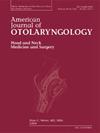Primary external auditory canal cholesteatoma: Clinical characteristics and role of endoscopic ear surgery
IF 1.7
4区 医学
Q2 OTORHINOLARYNGOLOGY
引用次数: 0
Abstract
Purpose
Primary external auditory canal cholesteatomas (PEACCs) are uncommon, and the role of endoscopy in managing the lesion has not yet been clarified. We aimed to investigate the clinical characteristics of PEACC and explore the feasibility of endoscopy for its treatment.
Material and methods
A retrospective study in patients who diagnosed with PEACC from January 2012 to January 2024 was conducted. The presenting features, disease extension according to Naim's classification, and treatment option used were assessed. The clinical characteristics were compared between the conservative successful group and the surgical group.
Results
A total of 72 patients who completed the treatment protocols were enrolled. Per the classification by Naim et al., PEACC was categorized as stage II, III, and IV in 7, 42, and 23 cases, respectively. Successful nonoperative treatment using the transcanal endoscopic approach was achieved in 46 patients without tympanic perforation (p = 0.035), scutum erosion (p < 0.001), ossicular involvement (p = 0.02), erosion of the vertical segment of the facial canal (p = 0.018), or mastoid involvement (p = 0.046), with maintenance of dry ear for 2 months (p < 0.001). Endoscopy-assisted and exclusive endoscopic surgery were performed in nine and ten patients, respectively. Canal wall-down mastoidectomy with obliteration was performed in seven patients with advanced stage IV disease. Complications were not reported in either group.
Conclusion
Endoscopy is useful for PEACC management even in advanced stages. However, the approach varies according to the lesion extent. Successful nonoperative management feasible in patients without tympanic membrane perforation, scutum erosion, facial canal erosion, ossicular or mastoid involvement and in those with ear drainage for <2 months.
原发性外耳道胆脂瘤:临床特点及内窥镜耳手术的作用
目的原发性外耳道胆脂瘤(PEACCs)并不常见,内窥镜检查在其治疗中的作用尚不明确。我们旨在探讨pacc的临床特点,探讨内镜治疗的可行性。材料与方法对2012年1月至2024年1月诊断为PEACC的患者进行回顾性研究。根据Naim分类法评估患者的表现特征、疾病扩展及治疗方案。比较保守成功组与手术组的临床特点。结果共纳入72例完成治疗方案的患者。根据Naim等人的分类,PEACC分别在7例、42例和23例中被划分为II期、III期和IV期。经鼻内镜入路非手术治疗46例患者,无鼓膜穿孔(p = 0.035)、皮囊糜烂(p <;0.001),听骨受累(p = 0.02),面耳管垂直段糜烂(p = 0.018)或乳突受累(p = 0.046),保持干耳2个月(p <;0.001)。内镜辅助手术和单独内镜手术分别为9例和10例。对7例晚期IV期疾病患者行乳突根治术。两组均未出现并发症。结论内窥镜检查对晚期pacc的治疗有重要意义。然而,根据病变程度的不同,入路也不同。对于无鼓膜穿孔、胸膜糜烂、面管糜烂、听骨或乳突受累者及耳部引流2个月的患者,非手术治疗成功可行。
本文章由计算机程序翻译,如有差异,请以英文原文为准。
求助全文
约1分钟内获得全文
求助全文
来源期刊

American Journal of Otolaryngology
医学-耳鼻喉科学
CiteScore
4.40
自引率
4.00%
发文量
378
审稿时长
41 days
期刊介绍:
Be fully informed about developments in otology, neurotology, audiology, rhinology, allergy, laryngology, speech science, bronchoesophagology, facial plastic surgery, and head and neck surgery. Featured sections include original contributions, grand rounds, current reviews, case reports and socioeconomics.
 求助内容:
求助内容: 应助结果提醒方式:
应助结果提醒方式:


